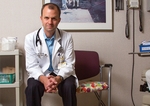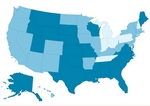profession
Most ED patients willing to wait longer to avoid nondoctor care
■ As the use of nurse practitioners and physician assistants increases, a survey urges greater disclosure about who provides care and their level of training.
By Kevin B. O’Reilly — Posted Aug. 30, 2010
- WITH THIS STORY:
- » Related content
Nurse practitioners and physician assistants account for at least 10% of outpatient visits and increasingly are being used to handle patient care in emergency departments, according to previous research.
But a new survey said 80% of patients expect to see a physician when they come to the ED. Fewer than half would be willing to see an NP or PA for an ankle injury -- they would rather wait two more hours to be cared for by a physician.
The survey of 507 ED patients at three teaching hospitals in Pittsburgh and Dallas found that, even for a minor complaint such as a cold symptom, only 57% would agree to see a nurse practitioner and 53% would see a physician assistant, according to the study in the August American Journal of Bioethics. Patients also preferred to see a fully trained physician compared with a medical resident, but not by as wide a margin as their desire to avoid nonphysicians.
Given their strong preferences for care from physicians, patients deserve greater disclosure about who is providing care and what the level of training is, said study lead author Gregory L. Larkin, MD, professor of emergency medicine at Yale University School of Medicine in Connecticut.
"If we are going to advertise ourselves as a high-quality health care system, we should be trying to think of patients as health care customers more than we have," Dr. Larkin said. "We have been handing down these alternative providers to patients without any level of informed consent whatsoever. ... We inadvertently mask the fact that they aren't really physicians, adorning them with long white coats, small name tags and high-end Littmann stethoscopes. It's very hard for the unsophisticated patient to tell who's caring for them."
Who takes care of patients?
The American Hospital Assn. has a policy stating that patients have a right to know who is caring for them and what their training is. American Medical Association policy says the word "physician" should be used only to reference medical doctors.
But Dr. Larkin said many physician extenders fail to introduce themselves properly.
"They'll simply go into, 'Hey, how are you doing today?' " he said. "Patients' self-reported interest in choice has been slaughtered on the altar of economic expediency."
Everyone agrees that patients deserve to know who is caring for them and should be allowed to request a physician's care, said Connie M. Ulrich, PhD, RN, associate professor of bioethics and nursing at the University of Pennsylvania School of Nursing.
"It's common courtesy that the health care professional introduces him or herself, so I see that as a basic primer of communication with patients and that is taught in nursing schools and medical schools," said Ulrich, who contributed a commentary to American Journal of Bioethics in response to Dr. Larkin's study. "Any time we can be transparent, we should be."
Ulrich said some nonphysicians may fail to identify themselves fully in a busy emergency department, but there is little evidence to show it happens most of the time.
"Does the public feel they're properly informed about the health care provider who is caring for them?" Ulrich said. "I don't think we have that data."
A fifth of the patients surveyed did not understand the levels of training and education associated with the roles of nurse practitioner, physician assistant and medical resident. In those cases, the patients were provided objective definitions that mentioned that nonphysicians' care is less costly.
But Ulrich said patients may still not understand the contribution to care made by nonphysicians.
"We get into this turf battle between physicians, nurse practitioners and other providers when the main purpose should be to meet the needs of the patient," she said. "With the way health care costs are increasing and how much our aging and chronically ill patients will need to receive care in a much broader, interdisciplinary fashion, we need all these different skill sets to be able to do that."












